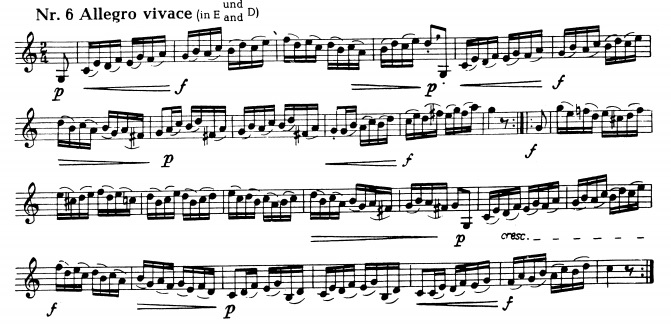Music
As always, although you can find these 60 studies for free on IMSLP.org, I recommend purchasing a copy if you are going to be playing them a lot (which you definitely should!) – the better editing and easy legibility is worth it! Here is the IMSLP music for Kopprasch #6:

Key Points
- One of the main (and most obvious) challenges in this etude are quick, small slurs both up and down.
- The primary melodic motion in this etude is up a third (either major or minor) and then down a step. Make sure you’re familiar with the sound of this pattern, so you can make sure to be as accurate as possible.
- Like many of the early Kopprasch etudes, the key is almost entire C major, with a few accidentals at the end of the first section/beginning of the second.
- All the dynamic changes are preceded by crescendos or diminuendos. There should be no subito dynamic changes.
Technical Tips
- For the small slur patterns, make sure that you practice lip slurs every day. Even though many of the notes are thirds or fourths apart, a lot of those intervals(especially below 3rd-space C) are neighboring harmonics. For example, although the first three notes are almost an octave apart, there are no notes in-between the low G, middle C, and E that are played “open” on the F horn (take a look at my harmonic series sheet if you don’t know what this means). These small slurs require only a small airspeed change (and very little increased lip tension) to play, so make sure that you are not using too much effort on these opening slurs.
- If you’re having trouble tonguing the note after the slur pattern, practice this articulation by slowing down the tempo, and deliberately shortening the second note, so that you can more easily hear (and have more time to focus on) the articulation of the tongued note. Once you are able to articulate it clearly and in-time, then you can lengthen the second note back up to its normal value, and only then bring the tempo back up to speed.
- Make sure the 8th note pickups are twice as long as the 16th notes that dominate the exercise. Trying to rush through these longer notes is a sure sign that your tempo isn’t steady and that you haven’t used a metronome!
- Pay special attention to the notes after the repeat sign. This pattern is a little bit tricky at first (especially in the higher register) so make sure you are 100% sure of the notes before you start speeding it up. Notice that the last note in bar 13 is different than the last note on beat 1 of bar 14 – practicing it an octave lower than written at first can be very helpful!

